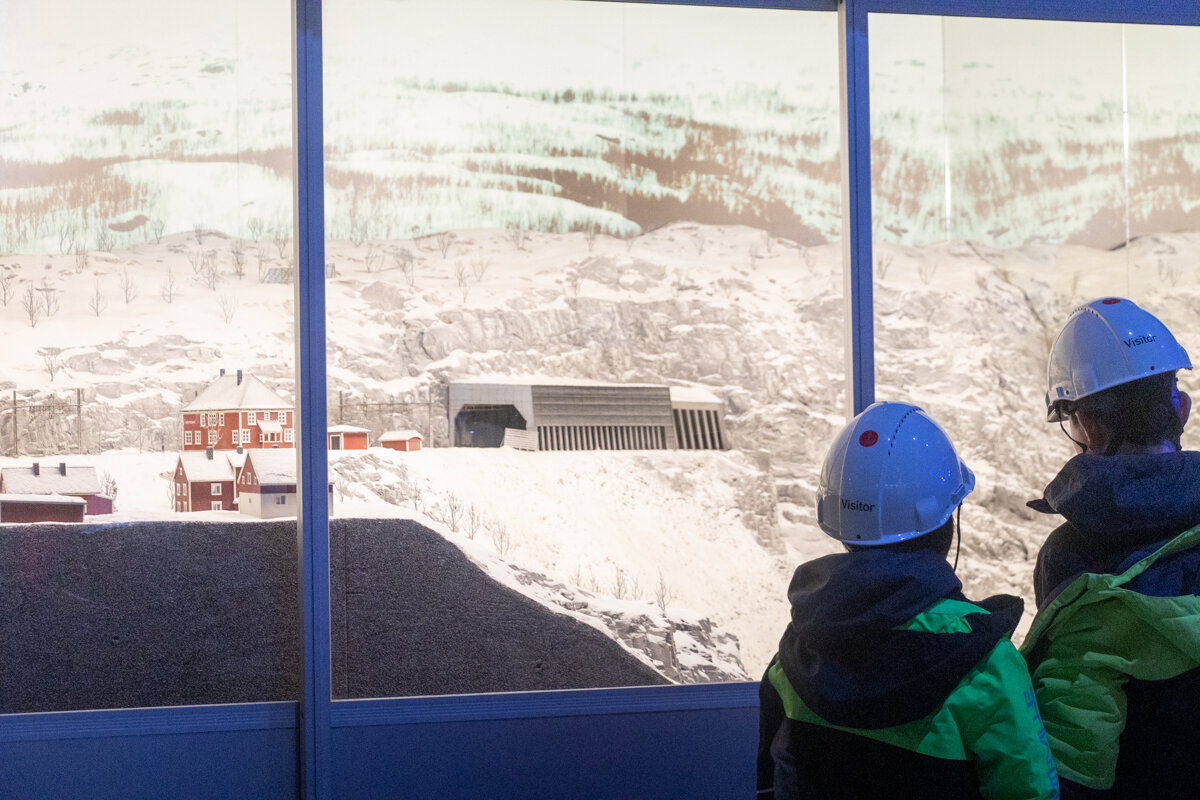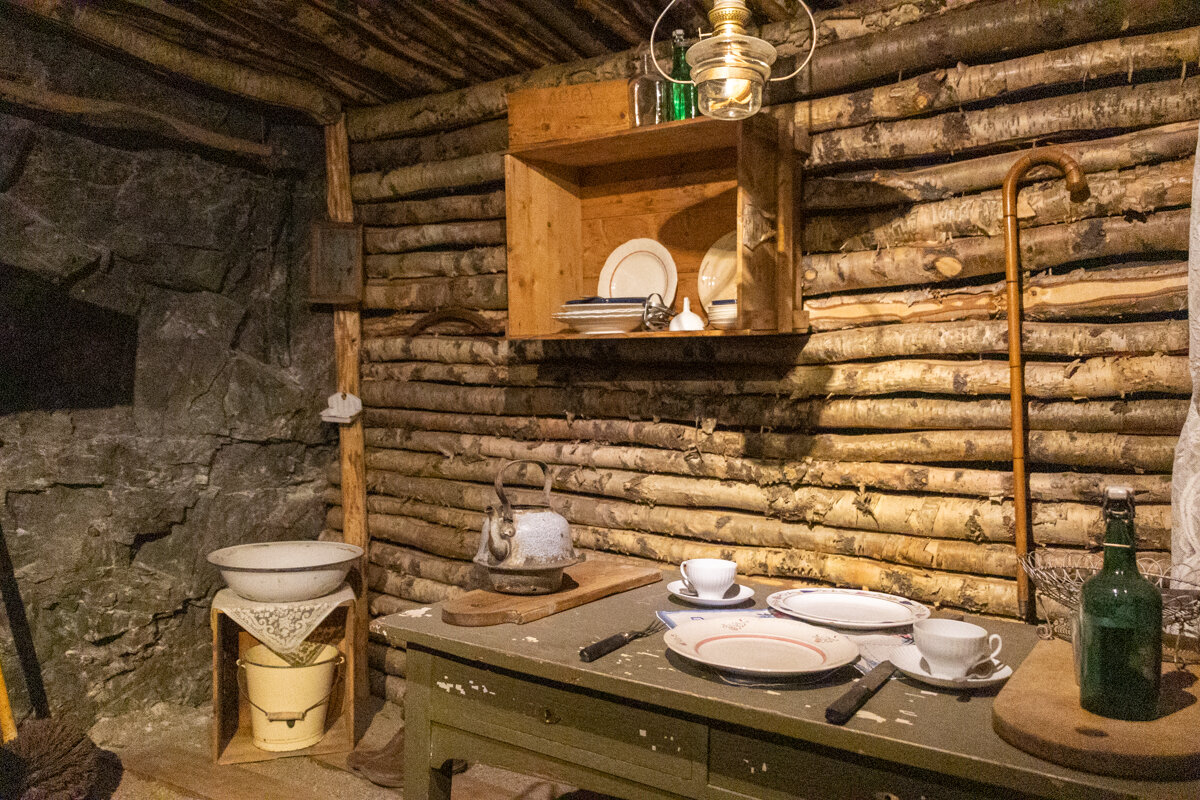Kiruna is intrinsically linked to its mining history. Located on the Kiirunavaara mountain, the Luossavaara-Kiirunavaara Aktiebolag or LKAB mine has been in operation since 1899. The world’s largest iron ore mine, it still supplies millions of tonnes of ore every year. A visit to Kiruna’s iron mine is a must!
On this tour, you’ll learn about the history, mineral processing and mining technology offered by LKAB, directly linked to the development of Kiruna.
Practical information
To help you prepare for your visit to the Kiruna Iron Mine, here’s the essential information you need to know.
Admission prices
If you’d like to visit the Kiruna Iron Mine, tickets are on sale at the Kiruna Lappland Tourist Center in Kiruna. However, we recommend that you book your tickets online in advance, as this is a very popular tourist activity in Kiruna, and tour groups are often fully booked.


Please note that for safety reasons, children under 6 years old and less than 1.10 m tall are not allowed to visit the iron mine.
Book your visit now to enter the world's largest iron ore mine and dive to a depth of 540 metres to discover the secrets of this industry.
If you’re worried about being cooped up during your visit, the tunnels are spacious and the tracks are clear. Unless you suffer from claustrophobia, you should be able to visit the Kiruna Iron Mine without difficulty.
Timetable for the visit to the Kiruna mine
The LKAB iron mine is open on Tuesdays, Thursdays, Fridays and Saturdays.
We advise you to check the LKAB website for tour availability, so that you can reserve a time slot without any inconvenience to your other activities.

Visits in English are possible. A high level of English is not required, as the site is committed to using vocabulary that is accessible to all. But you will still need to have a basic understanding if you wish to follow the guides’ explanations. If you want to visit the Kiruna mine, you’ll need to understand the guide’s language. Otherwise, all tours are conducted in Swedish.
Visit duration
Guided tours are available every day: a guided tour of the entire mine takes around 3 hours.


The equipment
You won’t need any special equipment for this tour. However, LKAB will provide you with a helmet, which you must wear for the duration of the tour.
Kiruna’s iron mine is underground, so you don’t have to worry about the cold. It maintains a temperature of around 10 degrees all year round, and you won’t need to cover up any more than necessary.

How do I get there?
As the iron mine is far from the town, all tours start from the Kiruna Lappland Tourist Center, where you’ll be picked up by bus.
Please note that if you arrive late, your tickets will be resold and you will not be reimbursed. You will not be able to join the tour after the indicated departure time. Make sure you get to the meeting point on time if you don’t want to miss the bus departure.

You can get there on foot. It’s right in the heart of Kiruna’s old town center, on the eastern edge of the city. If you’re coming by bus, you can stop at the Polisstation stop, a 2-minute walk from the Kiruna Lappland Tourist Center.
Free parking is available right in front of the center.
What does a visit to the Kiruna mine involve?
LKAB offers you a guided tour at a depth of 540 meters, where you can discover the history of this mining operation. So that you know what to expect when you visit the Kiruna iron mine, we’ll describe in detail how the operation works.
Video of the visit to the Kiruna iron mine
To immerse you directly in this universe, here is a short video that briefly recounts the highlights of this visit:
Pick-up from Kiruna center
At the start of the tour, you’ll meet in front of the Kiruna Lappland Tourist Center, located in the center of Kiruna, to the east of the city.
One by one, the guides will put you on a bus, checking your identity and reservation. It will then take you to the heart of the iron mine, more than five hundred meters underground.


The route
When you arrive, you’ll need to don a hard hat to enter the InfoMine. This is a disused mining tunnel in which the tour takes place. Here, the guide will tell you about the different stages of the tour and the safety rules.
First, he’ll show you a detailed map of the mine and tell you about its history, with links to Kiruna.


Next, you’ll be taken to an adjoining room. You’ll watch a 15-minute film about the LKAB mining company and the projects they plan to implement to reduce their CO2 emissions.
You’ll then go to the “mining school”, where you’ll learn, step by step, how magnetite is mined and transported from the mines to the production sites. As an aside, if you’re staying in Kiruna, you may be able to hear an explosion.
Every night, at around 1.30 am, LKAB drills its tunnels, producing vibrations that you can feel right in your bed!

The guide will then tell you about the transformation of the city of Kiruna using an interactive three-dimensional map. You’ll discover the various changes that will take place between now and 2035.
You can then take a look at the machines used in the mine, on display for the occasion. You can even climb inside one of them!



You’ll then arrive at the mine restaurant, where you can enjoy a fika break with a hot drink and Swedish cookies.
Finally, you’ll come to the last thoroughfare, where the museum is located. Here you can discover the history of the mine over the decades, the equipment used by the miners, and major advances such as the tramway…


You’ll then be invited to gather at the entrance to the Kiruna mine, where you’ll board the bus together and be escorted back to the Kiruna Lappland Tourist Center.
History of the Kiruna mine
Features of the Kiruna iron mine
The iron vein exploited by the Kiruna mine is 4 kilometers long and 80 meters wide. The deepest galleries are 1,365 meters deep and cover several hundred kilometers. It is the largest iron deposit currently in operation on the planet.

At 1365 meters below the earth’s surface, LKAB currently mines 80% of all the ore in the European Union. No less than 2 billion tonnes of magnetite, a type of iron, have been extracted to date.
Kiruna, a mining town since its foundation
Sweden has always been renowned for the quality of its steel. Indeed, its iron deposits are among the purest in the world. First prized by the Sami and then by the Swedish crown, the Kiruna region and its iron mines were forgotten before being rediscovered in the early 18th century by Samuel Mört and Anders Hackzell.


Until the end of the 19th century, however, the country had difficulty exploiting its iron mines due to the climate and lack of technical resources.
The discovery of a new technique for refining iron ore, coupled with the construction of a railway line between Luleå and Narvik in 1903, enabled Kiruna to develop into a prosperous city.
A mining town par excellence, Kiruna’s location was designed by Per Olof Hallman and Gustaf Wickman to be close to the iron ore deposits while benefiting from “milder” temperatures. Innovations such as the streetcar to bring workers to the mine entrances would enable Kiruna to develop further.
A highly sought-after region during the Second World War, most of Kiruna’s buildings were constructed in the 50s and 60s.
The largest open-pit mine in the world at the time, the Kiruna iron mine went underground in 1962 because the pit had become too large and too deep. The workers moved to the other side of the mountain, leaving the open pit abandoned.

Although mining remains a key activity in the Kiruna region, the economy is increasingly diversifying into industry and tourism.
Moving downtown
As early as 2004, LKAB noticed that underground fissures caused by explosions in the mines were getting closer to Kiruna’s town center.
To expand mining operations without hindering the development of Kiruna and to protect the local population, the authorities decided to move the town center 3 kilometers to the west.
Some buildings will be completely dismantled and rebuilt, like the Kiruna church, while others, like the Scandic Hotel, have been demolished and rebuilt from scratch.

This huge project has been underway since 2007 and is scheduled for completion in 2035. The city wants to rebuild itself with more pedestrianized streets and green spaces.
This unique project has already brought together some fifty architects from all over the world, and attracts many people curious to see this urban change.
A visit to Kiruna’s iron mine will immerse you in the history of the town’s mining past. If you’re looking for a unique and cultural activity to keep you busy for half a day in Kiruna, we invite you to do it!